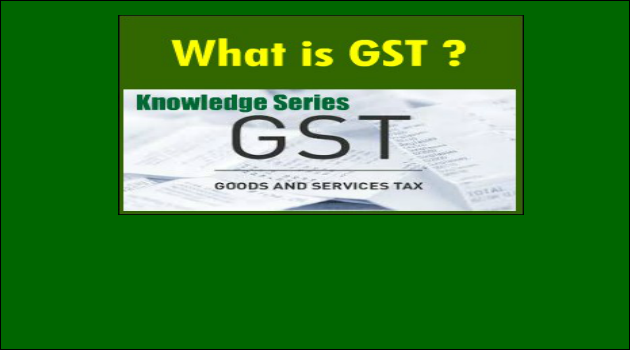Goods and Service Tax (GST) Knowledge Series 1

Special Column on GST Awareness
Goods and Service Tax (GST) is a major tax reform rather economic reform taken up by the Government. GST implementation requires knowledge updating and awareness for all stakeholders of the society. We know that once implemented, GST will have a great impact on the Tax Structure, Tax Incidence, Tax Computation, Valuation, Tax Payment, Compliance, Input Credit, Accounts & Records, Returns, Assessment, and Reporting of every business in the society leading to a complete overhaul of the current indirect tax system. New business models with supply chain system are bound to emerge and come forward. So the business community and tax professionals requires to be aware and updated about relevant issues of new GST law to be effective from 1st July 2017.
With an attempt to spread GST awareness among the readers of the Financial Bazar, the important aspects of GST law will be covered henceforth in every issue on regular basis. In this issue the basics of GST law are being highlighted below:
- GST is an integrated tax system which works on the concept of “One Nation One Tax”. Under the GST regime, all existing assessees under Central Excise, Service Tax and VAT have been migrated to the GST.
- Now every supplier of goods or services or both shall be liable to be registered under GST Act (s) in the State or Union territory other than special category of states from where he makes a taxable goods or services or both, if his aggregate turnover in a financial year exceeds Rs.20-lakhs.
- The GST law is roll out with effect from 1stJuly 2017 since both the houses of Parliament have cleared the four supporting GST legislations- i) Compensation Law Bill, 2017, ii) Central-GST (CGST) Bill, 2017, iii) Integrated-GST (IGST) Bill, 2017 and iv) Union Territory GST (UTGST) Bill, 2017. On 31st March 2017 the GST Council approved five amended rules for the Goods and Services Tax and gave a “tentative” nod to the remaining four rules.
- GST is applicable on the supply of goods or services as against the present concept of tax on the manufacture or sale of goods or provision of services.
- GST is a tax based on destination of consumption of goods and services. This means that tax would accrue to the State or the Union Territory where the consumption takes place.
- It is a dual GST with the Centre and States simultaneously levying tax on a common tax base and form. GST to be levied by the Centre on intra-State supply of goods or services would be called “CGST” and that to be levied by the States with their respective legislature and Union Territories would be called “ SGST” and UTGST” respectively. IGST is GST charged for movement of goods & services from one state to another.
- GST would apply to all goods other than alcoholic liquor for human consumption and five petroleum products, viz. petroleum crude, motor spirit (petrol), high speed diesel, natural gas and aviation turbine fuel.
- The Central GST (CGST) law has marked the peak rate at 20% and a similar rate has been prescribed in the State GST (SGST) law, which takes the max rate to 40% which will come into force only in financial exigencies. Similarly, IGST would be levied at 40% at its peak rate as pegged,
- GST Council in its meeting decided 4 tier structure of rates 5%, 12%, 18% and 28% (with cesses) in addition to zero rated and exempted goods or services.
- GST would apply to all services barring a few specified or to be specified by the Government.
- GST would replace the following taxes currently levied and collected by the Centre:
- Central Excise Duty
- Duties of Excise (Medicinal and Toilet Preparations)
- Additional Duties of Excise (Goods of Special Importance)
- Additional Duties of Excise (Textiles and Textile Products)
- Additional Duties of Customs (commonly known as CVD)
- Special Additional Duty of Customs (SAD)
- Service Tax
- Central Surcharges and Cesses so far as they relate to supply of goods and services
- State taxes that would be subsumed under the GST are
- State VAT
- Central Sales Tax
- Luxury Tax
- Entry Tax (all forms)
- Entertainment and Amusement Tax (except when levied by the local bodies)
- Taxes on advertisements
- Purchase Tax
- Taxes on lotteries, betting and gambling
- State Surcharges and Cesses so far as they relate to supply of goods and services
- The list of exempted goods and services would be common for the Centre and the States.
- Taxpayers with an aggregate turnover in a financial year up to Rs.20 lakhs would be exempt from tax. Aggregate turnover shall be computed on all India basis.
- For eleven Special Category States, like those in the North-East and the hilly States, the exemption threshold shall be Rest. 10 lakhs.
- All taxpayers eligible for threshold exemption will have the option of paying tax with input tax creit (ITC) benefits. Taxpayers making inter-State supplies or paying tax on reverse charge basis shall not be eligible for threshold exemption.
- Composition Scheme: Composition scheme is optional. Small taxpayers with an aggregate turnover in a financial year up to Rest. 50 laks shall be eligible for composition levy. Under the scheme, a taxpayer shall pay tax as a percentage of his turnover during the year without the benefit of ITC. The rate of tax for CGST and SGST/UTGST each shall not exceed
- 5% in case of restaurants etc
- 1% of the turnover in a state/ UT in case of a manufacturer
- 5% of the turnover in state/UT in case of other suppliers.
A taxpayer opting for composition levy shall not collect any tax from his customers nor shall he be entitled to claim any input tax credit. Taxpayers making inter-State supplies shall not be eligible for composition scheme. The government, may, on the recommendation of GST Council, increase the threshold for the scheme up to rupees one crore.
- An Integrated tax (IGST) would be levied and collected by the Centre on inter-State supply of goods and services. Accounts would be settled periodically between the Centre and the States to ensure that the SGST/UTGST portion of IGST is transferred to the Destination State where the goods or services are actually consumed.
- Use of Input Tax Credit: Taxpayers shall be allowed to take credit of taxes paid on inputs (input tax credit) and utilize the same for payment of output tax. However, no input tax credit on account of CGST shall be utilized towards payment of SGST/UTGST and vice versa. The credit of IGST would be permitted to be utilized for payment of IGST, CGST and SGST/UTGST in that order.
- HSN (Harmonized System of Nomenclature) code shall be used for classifying the goods under the GST regime. Taxpayers whose turnover is above Rs. 1.5 crore but below Rs. 5 crore shall use 2-digit code and the taxpayers whose turnover is Rs. 5 crore and above shall use 4-digit code. Taxpayers whose turnover is below Rs. 1.5 crore are not required to mention HSN Code in their invoices.
- Exports and supplies to SEZ shall be treated as zero-rated supplies. The exporter shall have an option to either pay output tax and claim its refund or export under bond without tax and claim refund of Input Tax Credit.
- Import of goods and services would be treated as inter-State supplies and would be subject to IGST in addition to the applicable customs duties.
In the next series we will discuss about special benefits and problems in the ensuing GST Regime.
- R. C Guria. M.Com, FCA. FIII

